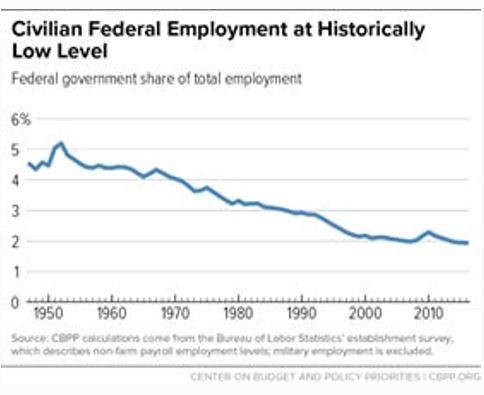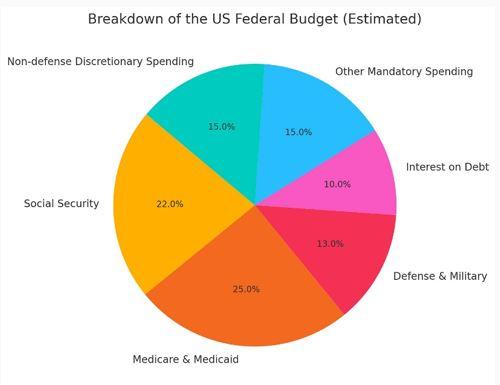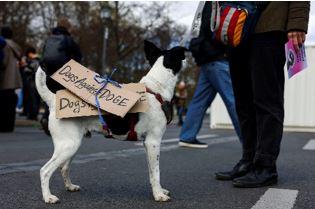| Tue. July 01, 2025 |
 |
|
||
|
||||
| ||||

A Quick Recap of What Gore/NPR Did
This article takes off from my last one (at davidphillips502.substack.com) which focused specifically on the Gore/NPR (National Performance Review, or National Partnership for Reinventing Government). The NPR was implemented by the Clinton-Gore administration as an interagency task force focused on reforming the U.S. federal Government. It took off from the apparently unshakeable belief, reinforced by Ronald Reagan in 1980, that the Federal workforce was bloated, inefficient and superfluous, even though it had, in fact, declined for many years as a percent of the US civilian workforce and in many areas was probably understaffed.

Leaving that aside, the NPR was quite successful in cutting the workforce through streamlining agencies and programs, early retirements and buyouts, outsourcing to the private sector, automation and trying to create a culture of performance and responsiveness. That is, it tried to cut the workforce as far as possible without traumatizing it. One of the key take-aways from that is that the waste problem has generally not been because of workforce inefficiency so much as the cost of regulation – hence the famous question - how does a six-dollar hammer in a shop become a four-hundred-dollar hammer in a public procurement?
The NPR was subject to heavy partisan criticism, as was the norm, especially under Newt Gingrich who was offering the People his ‘Contract with America.’ Critics claimed that it failed to significantly cut programs and downsize agencies, it lacked follow through, it was too focused on business process without addressing deeper issues of public accountability and democratic governance, it incorrectly tried to introduce private sector ideas of customer service, it was cosmetic rather than transformative, the savings it claimed to have achieved were questionable, and that it did not tackle outdated civil service rules or congressional micromanagement.
Many writers on both sides however now view NPR in a more favorable light. For example, at the Brookings Institution, Paul Light now describes it as the most ambitious and coherent federal reform effort since the New Deal. Others applaud technical innovations and digitization, and increased accountability. But probably the main achievement was that NPR managed to downsize the Federal Service without serious collateral damage - mass layoffs, damage to families, broken careers, etc.
Elaine Kamarck of Harvard and Brookings, who managed the NPR, testified before Congress on June 18, 2013, 20 years later, stating that ambitious targets had been achieved. The federal workforce, she stated, was reduced by 426,000 positions between January 1993 and September 2000, 20% of its starting size and higher than initial projections. In 2000 the federal government was estimated to be the smallest since Eisenhower. More than two-thirds of NPR regulations were modified, yielding $136 billion in savings to the taxpayer. She said: “we cut government the right way by eliminating what wasn’t needed – bloated headquarters, layers of managers, outdated field offices, obsolete red tape and rules.”
The civilian workforce level (excluding postal workers) which had averaged around 2.2 million for several years prior to 1993, dropped by nearly 20% between 1993 and 2002, the period in which the NPR was initiated and implemented. After 2002 there was a steady re-hiring, but rather than this being the result of poor design as claimed by the chorus on the Right, it was actually a result of several unpredictable events that forced major re-expansion - including the 9/11 attacks which triggered the re-hiring of staff in the DOD to support war in Afghanistan and Iraq, and the creation of security infrastructure, the TSA and the DHS. Extra staff were also hired to deal with the financial crisis, to support Obama’s medical insurance expansion, and later on, the COVID emergency (for more on this see newsletter of March 9).
The question now is - will Elon Musk’s DOGE be able, in the end, to surpass, or even to match, the achievement of the NPR, taking into account the rationale and approach it is using to make the cuts, the cost of those cuts, and whether the cuts will be truly consistent in the long run with a more efficient Government.
What Is the DOGE?
The Department of Government Efficiency (DOGE) was established on January 20, 2025, Inauguration Day, with the responsibility of cutting waste, fraud, and abuse in federal spending. The initiative has so far targeted federal agencies such as, inter alia, USAID, the Consumer Financial Protection Bureau (CFPB), the IRS, Medical-related agencies such as the NIH, CDC and FDA, the Department of Education (DE), Veterans Affairs (VA), Social Security Administration (SSA), Department of Health and Human Services (HHS), and Department of Homeland Security (DHS).
Elon Musk has been running the DOGE but has no formal role apart from Senior Advisor, a way apparently to shield him from legal challenges or charges of conflicts of interest. This has however been challenged in the Courts as unconstitutional as he is in effective command and should be appointed by Congress. The formal acting head of DOGE instead is Amy Gleason, a little-known former nurse and healthcare technology expert in the Government digital service. Under an Executive Order, Trump requires the Administrator to report on the progress of the workforce reforms within 240 days. The DOGE organization is due to be dissolved after six months, on July 4th, 2025.
By the end of January, DOGE installed Musk hirings at the top of agencies controlling critical parts of the government. To implement investigations "DOGE Teams" of four (team leader, HR expert, engineer, and lawyer) have been assigned to one or more federal agencies.
By March 19 DOGE had 89 employees according to its Acting Administrator, distributed through the various target agencies. Many are college age, the youngest being aged 19, a student at North Eastern University, and have no experience of Government, although many now have emporary Government posts. Some appear to have security issues from past work in small computer service firms and their nascent political interests, and some have been subject to threats.
Their main skills have been in fields of computer engineering, AI, and other STEM subjects, often borrowed from Musk’s companies. Other skills have been in venture capital, startups, and law. One area which would normally be important would be finance and economics, but this does not seem to be present in the DOGE.
The emphasis on computer engineering suggests that from the start the task was expected to concentrate on opening up secured databases and extraction of information in a search of fraud, rather than the serious evaluation of actual programs, or people.

The picture above seems to suggest something about the DOGE, an overall unseriousness in their interventions that maybe explains the skill choices and also unforced errors it has made rushing to publicize itself and its results.
Musk has asked for public patience to allow the DOGE to correct errors, explaining that expecting perfection is not reasonable. The problem is that, considering the highly privileged position that the DOGE has been given in order to do its work, and its supposedly brilliant staff, what has been done so far has been well short of perfection. The chainsaw and Elon’s funny hats suggest that executing a historic take-down of one of the World’s most consequential Governments is kind of a game.
Reuters on February 12 quoted two Republican budget experts’ view that the first phase of the effort to cut waste appears driven more by an ideological assault on federal agencies long hated by conservatives than a good-faith effort to save taxpayer dollars. It is interesting to note however that the cynicism and distrust of the Federal service, which started perhaps with Reagan’s 1980 announcement that ‘the government is the problem’, may be starting to get a rethink, at the prompting of, for example, Michael Lewis .
The DOGE Moves In
Reporting on the progress of the DOGE is difficult because of the rapid changes in strategy and plans, and extensive, often conflicting information. So, some of the following, while based on published sources, might be incorrect. The sheer volume of changes also means that I have to use just a few examples. Nevertheless, the story speaks for itself.
Elon Musk proposed initially a goal of cutting $2.0 trillion from the Federal Budget, about 30%. This was reduced to $1.0 trillion when it was realized that the original level would require cuts in the very large, politically charged spending areas like social security, Medicare, defense, veterans, and debt service which comprise together about three quarters of the total Federal budget. Even 15% is a very difficult target.

DOGE started work investigating waste and fraud in February, in association with the Office of Management and Budget (OMB) run by Russell Vought, an ultra-right follower of the so-called Unified Executive Theory and an architect of ‘Project 2025,’ the Republican blueprint that laid out the DOGE demolition plan. According to Politico, "the mass firings, the power grabs, and the agency shutterings are not just Musk's doing. They were planned and proposed well before Trump was even elected, right there for everyone to see, in Project 2025."
The DOGE started its chainsaw on ‘Diversity, Equity and Inclusion’ (DEI), one of the key targets of the Right, closing all Federal offices with a DEI function and terminating employees, including those who were thought simply to have been influenced by DEI. This was quickly followed by the firing of 17 inspectors general whose job is to audit federal agencies. Trump soon claimed that DOGE had discovered "billions and billions of dollars in waste, fraud and abuse" including 20 million people receiving Social Security past the age of 100, quickly shown to be an idiotic misreading by DOGE of the SSA database, and $2.7 trillion in improper Medicaid and Medicare payments to people overseas, similarly debunked. Nevertheless, the fraud claim was repeated by the President during March in Congress and on Fox News.
Thousands of federal employees were terminated by the end of February through, 1) Deferred Resignation in exchange for a period of administrative paid leave. According to the Office of Personnel Management (OPM) about 75,000 federal employees had accepted the offer as of mid-February but at less than 4% of the total Federal civilian staff this was totally inadequate, so terminations went ahead. 2) Probationary layoffs. Staff who have been in a position for less than a year could be easily laid off because they had yet to gain full civil service protection. 200,000 positions have reportedly come under this category.
Both have been blocked by Federal Judges pending arguments from the Administration and the labor unions regarding the legality of these actions -, how far Congress should be playing a role in the firings, and how far individual firings can take place without due process.
To carry out such interventions DOGE gained unprecedented access to data on millions of federal employees and the system handling all Federal payments and control of information policy, while cancelling access for OPM senior staff. They gained full access to payroll, human resources, and credentialing systems. Some Federal Staff dealing with Freedom Of Information (FOIA) requests have also been dismissed. Federal employees who objected to such take-overs were fired or placed on administrative leave pending investigation.
DOGE Assaults The Radical Left Lunatics
On February 1, members of DOGE demanded access to classified information at USAID. Security personnel who attempted to deny access were placed on Administrative leave. On March 18, DOGE announced the Agency’s closure. In another event, the USAID office signage in Washington DC was stripped from the front entrance of its Washington HQ in front of the cameras. At the CFPB, the watchdog agency set up after the 2008 financial crisis which the Right has attacked for regulatory excess, a similar event occurred when DOGE members entered the agency building to obtain access to data. To avoid any delay the next evening Russell Vought nominated himself head of the agency. Musk tweeted "CFPB RIP.”
This process was followed at the Department of Education (DE). Trump claimed that the DE harbors “radicals, zealots and Marxists." His selection for the new Education Secretary is Linda McMahon whose main credential for the job was that from 1980 to 2009, she had been the Founder and CEO of World Wrestling Entertainment. McMahon has called the Department "a big con job". Reportedly, DOGE members had been pushing high ranking DE officials out of their offices, competing to make the biggest budget cut headlines. By March 11, almost half of the workforce had been fired.
DOGE emphasized its operational transparency but its first report on its work on 17th February showed significant mis-reporting. On February 25, 21 US Digital Service employees who had remained after the DOGE took over their offices, resigned. They wrote: "We will not use our skills as technologists to compromise core government systems, jeopardize Americans' sensitive data, or dismantle critical public services".
A large number of Federal contracts were slated for termination, but on investigation the Wall St Journal found that there were inaccuracies in reported savings, including contracts that were counted multiple times or were no longer in force. On February 24, 2025, DOGE released over 2,000 additional contracts but nearly half were found by the AP not to be able to produce savings.
According to the most recent information, and subject to the usual disclaimer, at the SSA DOGE has implemented a budget cut accompanied by a 12% workforce reduction, while in the meantime customer service is collapsing because of closing of field offices, understaffing, and communications breakdown. Now that initiative seems to have been put into reverse. At the HHS staff reductions affecting 10,000 employees are intended across various agencies, including the FDA, NIH, and CDC, consolidating 28 divisions into 15 main units, potentially jeopardizing research and strategy. VA is expecting 80,000 staff losses, causing anxiety over provision of veteran care. DOGE has ordered funding cuts affecting services such as meals-on-wheels to over 2 million people annually. Trump has stopped federal grants and loans pending a review which could cause widespread disruption in health care research, education programs, and other initiatives. In the Department of Justice, a large number of career lawyers that worked on special counsel Jack Smith’s team and others investigating Trump, have been fired, as have State Department career diplomats.
The DOGE Miscues
A number of poorly planned firings by DOGE have resulted in more or less urgent re-hiring. In the Energy Department dismissals ran into immediate trouble because hundreds of employees tasked with working on the nation’s nuclear weapons programs were laid off and had to be reinstated, though the loss of email access hindered re-hiring. At the IRS thousands of probationary workers were expected to be fired in the middle of the tax season, no doubt resulting in further re-hiring. Federal Aviation Administration employees responsible for radar, landing, and navigational aid have also had to be re-hired. About 1,000 newly hired National Park workers were to be cut but these and several thousand other actions have been reversed for the tourist season. On February 19, the department also had to rehire workers responsible for dealing with the Avian Flu outbreak. Another reversal was to restore funding for food security relief, acknowledging that it was a mistake. On March 4, the GSA published a list of 443 properties to be sold, including headquarters and courthouses, but the list was taken down when it was found to wrongly include a sensitive federal complex.
The DOGE Criteria For Demolition
It has not been established exactly what criteria are being used by DOGE to select Agencies for the cut. A February 12 Reuters report quoted former Federal budget officials that the demolition “appears driven more by an ideological assault on federal agencies long hated by conservatives than a good-faith effort to save taxpayer dollars.” Matthew Vaeth, the new acting director of the OMB wrote: “the use of Federal resources to advance Marxist equity, transgenderism, and green new deal social engineering policies is a waste of taxpayer dollars that does not improve the day-to-day lives of those we serve.”
Foreign Aid, whose existence is a direct affront to ‘America First’ must be, by definition, abusive, and therefore wasteful, and probably fraudulent. The fierce determination to cut Aid is also odd because, apparently unknown to its opponents, it only accounts for about 0.15% of GDP. A 90-day hold in foreign assistance was ordered by Trump immediately on taking office and USAID was shut down. Secretary Rubio issued some exemptions such as emergency food programs and military aid to Israel and Egypt, but otherwise programs worldwide stopped or prepared to do so. As is the case with others this is now in the Courts.
In principle waste, fraud, and abuse should be determined by clear criteria. In the case of waste these could include programs that are not cost-effective, duplicated programs across agencies, or underutilized resources such as space or personnel. Fraud may include submission of incorrect information for financial gain, using government funds for unauthorized purposes, rigged bids, inflated contract costs, manipulated performance data, and kickbacks. Abuse could include using an official position for personal benefit, breaches of conduct guidelines, conflicts of interest, and violation of procurement protocols. Effectiveness and efficiency indicators should include capacity to successfully deliver products or services, quality of service delivery, cost-effectiveness (e.g. cost per outcome and impact), and return on capital/investment in the case of quantifiable outputs. The area of economic or financial return on investment would need the DOGE team to include accountants and economists, which it does not have. The regular indicators are however obviously not applicable in a program apparently determined by ideology and magical thinking rather than facts.
DOGE Results So Far
My position on interpreting these results is biased downwards. Maybe this is unfair but, to repeat, considering the gravity of the DOGE’s responsibilities and the privileged position that it has been given in order to do its work, a very high standard of unbiased reporting of results might be expected. What has been done so far is way short of that standard and suggests a lack of seriousness in doing it and a strong political bias of its own. Or, if the young DOGE super-sleuths engaged on the search can’t reasonably identify the fraud, well, let them just assume it!
According to a Tracking Service (Challenger), since the start of February up to date DOGE actions have led to about 280,000 layoffs of federal workers and contractors, impacting 27 agencies. However, the reliability of this estimate may not be great given the fast-moving changes that have been liable to modification and reversal.
As of March 24, 2025, DOGE has claimed to have saved $130 billion. Independent analysis however has found that DOGE's reports mis-counted tens of billions of dollars, with more than a third of contracts already paid off or legally obligated. There have also been multiple claims of significant fraud, none of which have been adequately confirmed, and DOGE seems to be redefining fraud to include political opposition.
Fortune and other news media on February 25 ran reports of DOGE’s claim, after only about a month of work, that it had identified savings of $55 billion. Actually, its website showed only $16 billion, but it also made an error mislabeling a contract at $8 billion that should have been $8 million, with the result that total saving would far less. The mislabeled contract was with D & G Support services, a small company with 180 employees who were providing services to the Immigration and Customs Enforcement (ICE), the Agency responsible for arrests and removals of immigrants and whose total annual budget was only $9 billion. Another error gleefully announced by the relentlessly well-informed Press Secretary Karoline Leavitt was the epic story of ‘Condoms to Gaza’ worth $50 million, or possibly $100 million, which did not exist. This was because the destination of the condoms was a different Gaza, that is, Gaza province in the East African nation of Mozambique where USAID had been assisting in HIV control through a Community Care Program. DOGE seem not to have had any geographers on their staff at the time but may have remedied this by now.
Citing these mistakes may be ‘unfair’ because they are anecdotes not scientifically representative – a common practice of conspiracy theorists especially on the Right. But Elon Musk pledged to transparency in DOGE’s operations and these accounting slip-ups raise serious questions about their self-reporting, their seriousness, and their level of accountability. Maybe a search for waste and abuse could look at DOGE?
Who Has Done Best – Gore/NPR or Musk/DOGE, and So What?
If we want to assess a program we should look at both costs and benefits. But looking at money costs here is less important than looking at ‘negative benefits,’ - a.k.a collateral damage. The issue is, what did either program do in terms of benefits and what was the collateral damage.
It’s too early to assess the Musk/DOGE intervention but indications are not good because of the way it has been carried out. First, there is a sense that a key reform task is not being taken seriously. Secondly, and related, it is likely a mistake to assign junior investigators with zero government experience to propose cutting major agencies and thousands of jobs. A third is the heavy use of engineers searching databases and even email chains looking, so far it seems in vain, for fraudulent numbers rather than reviewing the value of existing jobs and programs, their cost-effectiveness, or returns on investment. A fourth is the presence of attorneys whose job seems to be to advise on forced entry, seizing records or stripping existing staff of their authority. It is not clear how this oppositional approach can yield improvements in efficiency. Instead, it is likely to create long-term anger, demoralization of remaining staff, a sense that the rule of law has been violated, and a further unjustified undermining of the public’s view of the utility of Government service.

The NPR on the other hand set out to avoid action which undermined the Government. While layoffs are not joyful events the NPR faced mainly institutional resistance such as union opposition to the cuts, and staff opposition to e.g. digitization and change of culture. And many NPR principles and changes have been adopted by the following Administrations.
While it faced institutional opposition the NPR hardly faced legal challenges, but the DOGE has, due to its highly intrusive approach, faced extensive legal action around dismantling agencies, accessing buildings and confidential data, and resistance from agencies who instructed staff to disregard its directives (e.g. the NIH).
Finally, to what extent were workforces reduced in size? For the NPR we have measures ranging from an initial target of 250,000 to a reported achievement of 426,000 posts over 1993 to 2000, or about 20% of the starting number. In the case of the DOGE the most recent estimate is that about 280,000 staff have been cut (about 14%) over three months, although we don’t know how far that is subject to legal challenge, union challenge, departmental review, or simply wrong. It is clear though that the NPR cuts came with significantly less collateral damage than have the DOGE cuts. So the answer to the question depends on the size of each and how we weigh cuts against collateral damage. That answer will hopefully come soon enough to stop the destruction of the Government and mass layoffs throughout the US.

First appeared in EVIDENCE, REASON AND GASLIGHT -
Subscribe at davidphillips502.substack.com
| Comments in Chronological order (0 total comments) | |
| Report Abuse |
| Contact Us | About Us | Donate | Terms & Conditions |
|
All Rights Reserved. Copyright 2002 - 2025